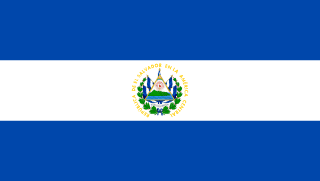El Salvador - Geography

Here, let us take a look at the Geography of El Salvador. Smallest Central American country and only one without a coastline on the Caribbean Sea. Mother's mean age at first birth is 20.8 years (2008 est.) (Note: data represents median age at first birth among women 25-29), whereas, the Maternal mortality ratio is 43 deaths/100,000 live births (2020 est.)
Geographical data of El Salvador
| Location | Central America, bordering the North Pacific Ocean, between Guatemala and Honduras |
|---|---|
| Geographic coordinates | 13 50 N, 88 55 W |
| Map references | Central America and the Caribbean |
| Tarrain | mostly mountains with narrow coastal belt and central plateau |
| Natural Resources | hydropower, geothermal power, petroleum, arable land |
| Natural Hazards | known as the Land of Volcanoes; frequent and sometimes destructive earthquakes and volcanic activity; extremely susceptible to hurricanes volcanism: significant volcanic activity; San Salvador (1,893 m), which last erupted in 1917, has the potential to cause major harm to the country's capital, which lies just below the volcano's slopes; San Miguel (2,130 m), which last erupted in 2002, is one of the most active volcanoes in the country; other historically active volcanoes include Conchaguita, Ilopango, Izalco, and Santa Ana |
| Irrigated Land | 240 sq km (2022) |
| Major rivers (by length in km) | |
| Major aquifers | |
| Land Boundaries | 590 km |
| Border Countries | Guatemala 199 km; Honduras 391 km |
| Coastline | 307 km |
| Climate | tropical; rainy season (May to October); dry season (November to April); tropical on coast; temperate in uplands |
| Area | |
| Total Area | |
| Land Area | 20,721 sq km |
| Water Area | 320 sq km |
| comparative Area | about the same size as New Jersey |
| Maritime Claims | |
| Territorial sea | 12 nm |
| Contiguous zone | 24 nm |
| Exclusive economic zone | 200 nm |
| Elevations | |
| Highest point | Cerro El Pital 2,730 m |
| Lowest point | Pacific Ocean 0 m |
| Mean elevation | 442 m |
| Land Use | |
| Agricultural land | 57.7% (2022 est.) |
| Agricultural land: arable land | arable land: 34.8% (2022 est.) |
| Agricultural land: permanent crops | permanent crops: 7.7% (2022 est.) |
| Agricultural land: permanent pasture | permanent pasture: 15.2% (2022 est.) |
| Forest | 27.7% (2022 est.) |
| Other | 14.5% (2022 est.) |
Population Distribution
Athough it is the smallest country in land area in Central America, El Salvador has a population that is 18 times larger than Belize; at least 20% of the population lives abroad; high population density country-wide, with particular concentration around the capital of San Salvador
People and Society
In El Salvador, the different Ethnic groups are such that we have: Mestizo 86.3%, White 12.7%, Indigenous 0.2% (includes Lenca, Kakawira, Nahua-Pipil), Black 0.1%, other 0.6% (2007 est.)
| Population | |
|---|---|
| Pop growth rate | 0.34% (2024 est.) |
| Birth rate | 17.1 births/1,000 population (2024 est.) |
| Death rate | 5.9 deaths/1,000 population (2024 est.) |
| Health expenditure | 9.7% of GDP (2021) |
| Physicians Density | |
| Hospital bed Density | 1.2 beds/1,000 population (2017) |
| Total fertility rate | 2.02 children born/woman (2024 est.) |
| Gross reproduction rate | 0.98 (2024 est.) |
| Contraceptive prevalence rate | 71.9% (2014) |
| Est married women (ages 15-49) | 55% (2023 est.) |
| Literacy | age 15 and over can read and write |
| Education expenditures | 4.1% of GDP (2020 est.) |
| Net Migration rate | -7.7 migrant(s)/1,000 population (2024 est.) |
| Nationality | Salvadoran | Salvadoran(s) |
| Languages | |
| Religions | Roman Catholic 43.9%, Protestant 39.6% (Evangelical - unspecified 38.2%, Evangelical - Methodist 1.3%, Evangelical - Baptist 0.1%), none 16.3%, unspecified 0.2% (2023 est.) |
| Age Structure | |
| 0-14 years | 25.3% (male 855,841/female 818,642) |
| 15-64 years | 66.3% (male 2,077,745/female 2,317,416) |
| 65 years and over | 8.4% (2024 est.) (male 238,658/female 320,400) |
| Dependency Ratios | |
| Total dependency ratio | 51.3 |
| Youth dependency ratio | 39 |
| Elderly dependency ratio | 12.3 |
| Potential support ratio | 8.1 (2021 est.) |
| Median Age | |
| Total | 29.7 years (2024 est.) |
| Male | 28.2 years |
| Female | 31.2 years |
| Urbanization | |
| Urban population | 75.4% of total population (2023) |
| Rate of urbanization | 1.33% annual rate of change (2020-25 est.) |
| Major urban areas (Pop) | 1.116 million SAN SALVADOR (capital) (2023). |
| Sex Ratio | |
| At birth | 1.05 male(s)/female |
| 0-14 years | 1.05 male(s)/female |
| 15-64 years | 0.9 male(s)/female |
| 65 years and over | 0.74 male(s)/female |
| Total population | 0.92 male(s)/female (2024 est.) |
| Infant Motality | |
| Total | 11.7 deaths/1,000 live births (2024 est.) |
| Male | 13.3 deaths/1,000 live births |
| Female | 10 deaths/1,000 live births |
| Life Expectancy at birth | |
| Total population | 75.9 years (2024 est.) |
| Male | 72.4 years |
| Female | 79.5 years |
| Drinking Water Sources | |
| Improved: urban | urban: 99.6% of population |
| Improved: rural | rural: 94.2% of population |
| Improved: total | total: 98.2% of population |
| Unimproved: urban | urban: 0.4% of population |
| Unimproved: rural | rural: 5.8% of population |
| Unimproved: total | total: 1.8% of population (2020 est.) |
| Sanitation facility acess | |
| Improved: urban | urban: 100% of population |
| Improved: rural | rural: 97.1% of population |
| Improved: total | total: 99.2% of population |
| Unimproved: urban | urban: 0% of population |
| Unimproved: rural | rural: 2.9% of population |
| Unimproved: total | total: 0.8% of population (2020 est.) |
| Alcohol consumption per capita | |
| Total | 2.94 liters of pure alcohol (2019 est.) |
| Beer | 1.5 liters of pure alcohol (2019 est.) |
| Wine | 0.06 liters of pure alcohol (2019 est.) |
| Spirits | 1.37 liters of pure alcohol (2019 est.) |
| Other alcohols | 0 liters of pure alcohol (2019 est.) |
| Tobacco use | |
| Total | 7.9% (2020 est.) |
| Male | 14.1% (2020 est.) |
| Female | 1.7% (2020 est.) |
| Child marriage | |
| Women married by age 15 | 4.3% |
| Women married by age 18 | 19.7% (2021 est.) |
Demographic profile
All Important Facts about El Salvador
Want to know more about El Salvador? Check all different factbooks for El Salvador below.
-
 El Salvador Factbook
El Salvador Factbook
-
 The Economy of El Salvador
The Economy of El Salvador
-
 Learn about the Government of El Salvador
Learn about the Government of El Salvador
-
 Communication in El Salvador
Communication in El Salvador
-
 Popular Universities in El Salvador
Popular Universities in El Salvador
-
 Enerny in El Salvador
Enerny in El Salvador
-
 Transport in El Salvador
Transport in El Salvador
-
 The Geography and society of El Salvador
The Geography and society of El Salvador
-
 The Environment of El Salvador
The Environment of El Salvador
-
 Military and security in El Salvador
Military and security in El Salvador